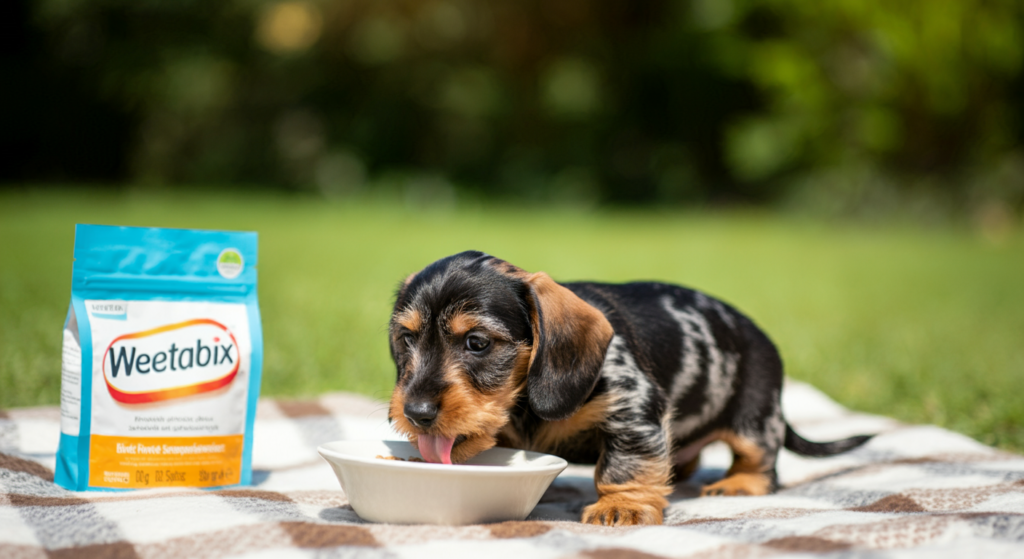Can dogs eat Weetabix?
Weetabix and Wagging Tails: Breakfast Treat or Trouble?
As dog owners, we’re always mindful of what’s safe and nutritious for our furry friends. With so many human foods being potentially harmful to dogs, it’s natural to question everyday staples in our diet. Weetabix, a beloved breakfast cereal enjoyed by many households, often sparks curiosity: “Can dogs eat Weetabix?” While it’s a healthy option for humans, is it suitable for our canine companions? Let’s break it down to help you make informed choices about sharing your breakfast with your pet.
Can Dogs Eat Weetabix?
Yes, dogs can eat Weetabix, but only in moderation and under specific conditions. While not toxic, Weetabix is not an essential or ideal part of a dog’s diet. It’s crucial to consider factors like portion size, added ingredients, and your dog’s individual dietary needs. Let’s dive deeper to ensure you’re making the best choice for your dog’s health.
Table of Contents
What Is Weetabix?
Weetabix is a whole-grain wheat cereal, often consumed with milk and sometimes sweetened with sugar or honey. Known for its high fibre content, Weetabix is marketed as a healthy, energy-boosting breakfast option for humans. It’s low in fat and provides a range of vitamins and minerals, such as:
- Iron: Supports oxygen transport in the blood.
- Folic Acid: Aids in cell development and growth.
- B Vitamins: Essential for energy metabolism and overall health.
However, for dogs, the simplicity of plain Weetabix can be a double-edged sword. While it’s not harmful on its own, the addition of milk, sugar, or other toppings can make it unsuitable. Understanding these nuances is key before offering Weetabix to your pet.

Benefits of Weetabix for Dogs
When prepared correctly and offered sparingly, Weetabix can provide some minor benefits to dogs. While not essential to their diet, here are a few potential positives:
1. Rich in Dietary Fibre
Weetabix contains fibre, which can aid digestion and help regulate bowel movements. This can be beneficial for dogs prone to mild constipation. However, excessive fibre can cause digestive upset, so portion size is key.
2. Provides a Quick Energy Boost
Whole grains like those in Weetabix are a source of carbohydrates, which can provide a quick energy boost for active dogs. However, dogs primarily derive energy from proteins and fats, so this benefit is minimal.
3. Trace Nutrients
While not nutritionally significant for dogs, Weetabix does contain trace amounts of vitamins and minerals, such as iron and folic acid, that may support their overall health in very small quantities.
Are Weetabix Bad for Dogs?
While not inherently harmful, Weetabix can pose risks if consumed in large quantities or prepared with unsuitable ingredients. Here’s what to watch out for:
1. Digestive Upset
Too much fibre can lead to diarrhoea or bloating. Dogs not accustomed to grains may experience stomach discomfort after eating Weetabix.
2. Milk Sensitivity
Many dogs are lactose intolerant, meaning they struggle to digest milk. Feeding your dog Weetabix with milk can cause:
- Diarrhoea
- Vomiting
- Gas or bloating
Tip: Serve Weetabix dry or with a small amount of water if necessary.
3. Excess Calories
While Weetabix is low in fat, it contains calories that can add up, particularly for smaller or less active dogs. Overfeeding can contribute to weight gain or obesity.
4. Added Ingredients
Avoid Weetabix with sugar, honey, or toppings like chocolate or raisins, as these can be toxic to dogs. Always check the label for added ingredients.
How Much Weetabix Can Dogs Eat?
Portion control is crucial when feeding Weetabix to dogs. Here are some guidelines:
- For small dogs, a small piece of a single biscuit is sufficient.
- For medium to large dogs, half a biscuit can be offered.
- Always offer it as an occasional treat, not a dietary staple.
Tip: Observe your dog’s reaction to ensure they tolerate it well.
Potential Dangers of Dogs Eating Weetabix
While generally safe in moderation, there are some risks to consider:
1. Weight Gain
Regular consumption of high-carbohydrate foods like Weetabix can lead to unnecessary weight gain, especially in less active dogs.
2. Allergic Reactions
Some dogs may be sensitive to wheat or gluten, resulting in:
- Itchy skin
- Digestive upset
- Ear infections
Tip: Monitor for signs of intolerance and consult your vet if symptoms appear.
3. Unbalanced Diet
Dogs require a balanced diet rich in proteins and fats. Over-relying on human foods like Weetabix can lead to nutritional deficiencies over time.
Alternatives to Weetabix
If you’re looking for safer and healthier options for your dog, consider these alternatives:
- Plain cooked oatmeal (unsweetened and unflavoured)
- Plain cooked rice
- Low-sugar dog treats specifically designed for canine consumption
- Fresh fruits like apples or blueberries (ensure seeds are removed)
Final Thoughts
So, can dogs eat Weetabix? The answer is yes—but with precautions. Plain, dry Weetabix in moderation is safe for dogs but should never replace their regular meals. Avoid adding milk, sugar, or other toppings, and always keep portion sizes small. If your dog shows any signs of digestive upset or allergies, discontinue feeding and consult your veterinarian.
Your dog’s health and happiness should always come first. While sharing your breakfast can be a fun bonding experience, it’s essential to prioritise their specific dietary needs.
Have you tried giving your dog Weetabix? Share your experience in the comments below!

FAQ – What dog owners are asking.
1. Can dogs eat Weetabix UK?
Yes, dogs in the UK and elsewhere can eat Weetabix in moderation, but only when served plain and without milk, sugar, or other additives. Weetabix should be an occasional treat rather than a regular meal, as it does not meet the nutritional needs of dogs.
2. Can dogs eat Weetabix with milk?
No, it is not recommended to serve Weetabix with milk to dogs. Most dogs are lactose intolerant, and consuming milk can lead to digestive issues such as diarrhoea, vomiting, or gas. If you wish to serve Weetabix, it’s best to do so dry or with a small amount of water.
3. Can dogs eat Weetabix with water in the morning?
Yes, Weetabix mixed with a small amount of water is safe for dogs as an occasional treat. Avoid serving it as a replacement for their balanced diet. Adding water softens the cereal, making it easier for dogs to consume, especially for senior dogs or those with dental issues.
4. Can dogs eat Weetabix in the morning?
Yes, dogs can eat Weetabix in the morning, but it should not be their primary breakfast. A small piece of plain, dry Weetabix or one softened with water is safe. However, dogs require a diet rich in proteins and fats, so their regular dog food should remain the primary focus.
5. Can dogs eat Weetabix every day?
No, it is not advisable to feed Weetabix to dogs daily. While it is safe in small quantities, frequent consumption of Weetabix can lead to an unbalanced diet, weight gain, or digestive issues due to its high carbohydrate and fibre content.
6. How to make Weetabix for puppies?
To make Weetabix for puppies, use the following method:
- Crumble a small piece of plain Weetabix.
- Add a little warm water to soften it.
- Avoid using milk, sugar, or other additives.
Serve only a very small portion as an occasional treat. Puppies have developing digestive systems and require a nutrient-rich diet specifically formulated for their growth needs.
7. Is Weetabix good for dogs’ glands?
Weetabix is sometimes suggested for its fibre content, which may help with firming stools and indirectly aid in expressing anal glands. However, this should only be done under veterinary guidance. Dogs with gland issues often require specialised diets or treatments, so consult your vet before relying on human foods like Weetabix for this purpose.
8. Can Weetabix help dogs with diarrhoea?
Weetabix is not a suitable remedy for diarrhoea in dogs. While fibre can help regulate bowel movements, excess fibre may worsen diarrhoea. Dogs with diarrhoea should follow a bland diet, such as plain boiled chicken and rice, and be seen by a vet if symptoms persist.
This FAQ provides answers to common questions, ensuring dog owners are well-informed about safely offering Weetabix to their pets. Let me know if you’d like to expand or revise any section!
